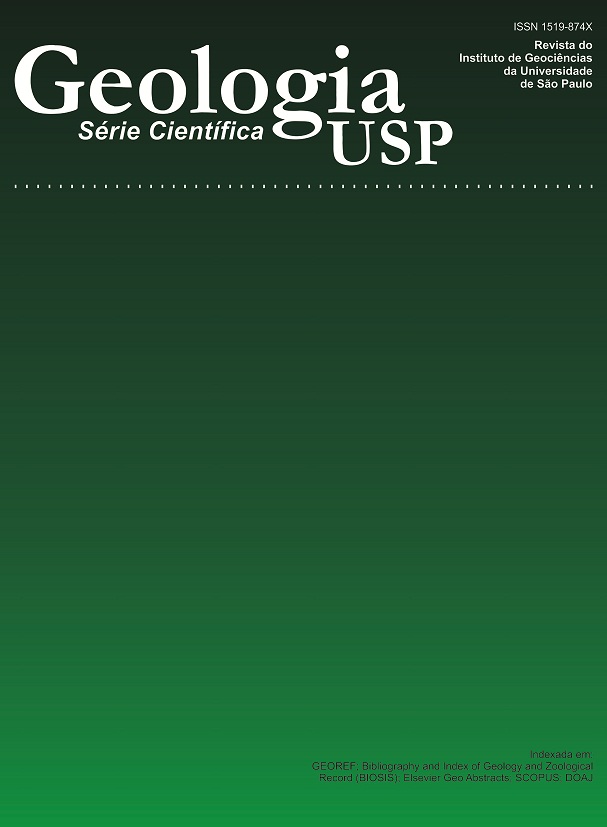Pillow basalts of Morro do Agostinho Ophiolite Suite: records of seafloor in the midwestern portion of Araguaia Belt
DOI:
https://doi.org/10.5327/Z1519-874X201300040006Abstract
Along the domain of low metamorphic grade (Midwestern portion) of the Araguaia Belt, outcrop dozens mafic and/or ultramafic bodies of ophiolitic suites. An example is the Morro do Agostinho Ophiolite Suite, in the surroundings of the city of Araguacema (Tocantins) that configures a small isolated body that sustains the Morro do Agostinho and is tectonically emplaced in meta-sandstones, slates and phyllites of Couto Magalhães Formation (Tocantins Group). The Morro do Agostinho Ophiolite Suite consists of serpentinized peridotites, basalts and ferriferous cherts. The association of basalts is characterized by a significant layer of submarine pillow lavas overlying serpentinized peridotites. The basalts were classified into massive and hialobasalts types. Massive basalts are homogenous, with intersertal texture that is essentially composed of thin laths and acicular crystals of plagioclase and clinopyroxene and present rare crystals of olivine, chalcocite and chalcopyrite. Hyalobasalt shows ultra-fast cooling features (quenching) as spherulites, radial, acicular and skeletal crystals of plagioclase and clinopyroxene with forms of swallowtail. Geochemical data, including (La/Yb)n and (La/Sm)n ratios less than 1, indicate a subalkaline-tholeiitic MORB nature of the basalts. These rocks show that during the geological evolution of Araguaia Belt, there was an oceanization stage of Araguaia Basin, with litospheric mantle's exposure, followed by lava's extravasation and sedimentation of cherts and banded iron formation in deep ocean environment. After sedimentary filling of the Couto Magalhães Formation (Tocantins Group), the tectonic inversion, which led to the exhumation of the ophiolitic bodies, especially along thrust surface, with fragmenting and tectonic mixing with supracrustal rocks, accompanied by regional metamorphism under conditions of low green schist facies. The Morro do Agostinho Ophiolite Suite therefore represents a small allochthonous fragment of a well-preserved ocean mantle/crust lithosphere, similar to the others examples found in the Araguaia Belt who marks the Araguaia Basin's moment of oceanization during the Neoproterozoic.Downloads
Download data is not yet available.
Downloads
Published
2013-12-01
Issue
Section
Articles
License
Authors who publish in this journal shall comply with the following terms:
- Authors keep their copyright and grant to Geologia USP: Série Científica the right of first publication, with the paper under the Creative Commons BY-NC-SA license (summary of the license: https://creativecommons.org/licenses/by-nc-sa/4.0 | full text of the license: https://creativecommons.org/licenses/by-nc-sa/4.0/legalcode) that allows the non-commercial sharing of the paper and granting the proper copyrights of the first publication in this journal.
- Authors are authorized to take additional contracts separately, for non-exclusive distribution of the version of the paper published in this journal (publish in institutional repository or as a book chapter), granting the proper copyrights of first publication in this journal.
- Authors are allowed and encouraged to publish and distribute their paper online (in institutional repositories or their personal page) at any point before or during the editorial process, since this can generate productive changes as well as increase the impact and citation of the published paper (See The effect of Open Access and downloads on citation impact).
How to Cite
Miyagawa, L. de J. P. P., & Gorayeb, P. S. de S. (2013). Pillow basalts of Morro do Agostinho Ophiolite Suite: records of seafloor in the midwestern portion of Araguaia Belt . Geologia USP. Série Científica, 13(4), 111-124. https://doi.org/10.5327/Z1519-874X201300040006





